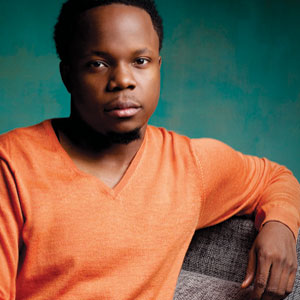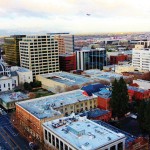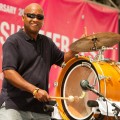The announcement that Michael Miller would be stepping down as executive director of San Jose Jazz shocked a lot of people. Neither the group itself nor the local reporting on the story gave any clear reason for Miller’s jump to the smaller Children’s Musical Theater San Jose—other than the vague notion that it was related to San Jose Jazz’s collaboration with 1stACT Silicon Valley—leading to speculation about what was going on behind the scenes.
The timing seemed troublesome, too, with 1stACT director of cultural participation (and Left Coast Live co-organizer) Brendan Rawson taking over as head of the group almost immediately, just as the group’s fledgling Winter Fest expands at San Pedro Square this weekend.
“For the public, it’s like ‘Oh, my God, what did they just do?’” admits Miller. “But this has really been a long, thought-out strategic process for three different organizations.”
“We’ve been planning for at least seven months,” says Rawson. “It’s come to a head real fast here the past several weeks, as we’ve involved the board of directors of 1stACT and San Jose Jazz and CMT, and the staffs. But it’s been something that Michael originated in his head quite a while ago.”
The question, of course, is still why? Miller wasn’t secretly pushed out, and he didn’t flee the scene after leading San Jose Jazz for just a year. The real reason is a far more interesting one, and may point a way for other arts organizations.
Perhaps it shouldn’t be a surprise that at its core, the move is about money. But in a larger sense, it’s also about trying to find new operational models to help organizations like San Jose Jazz thrive—and even expand their programming—in a post-recession world.
Three years ago, San Jose Jazz lost Comcast as a sponsor, a huge blow that the group is still rebuilding from. 1stACT is a group funded by arts foundations (as well as Adobe, Applied Materials and Cisco) to provide support services for arts organizations. What this move is really about is allowing San Jose Jazz to save a lot of money by having 1stACT funding pay for certain positions in the organization—including Rawson’s. {pagebreak}
“Purely on a financial level, the deal with 1stACT brings Brendan in as a loan executive for 18 months. So my salary goes out of the budget for 18 months. It allows us to do some really smart things. It frees up some finances. It just makes sense,” Miller explains.
The Jedi-mind-trick part of this move is that Miller is in actuality staying on with San Jose Jazz in a lot of ways. He’ll be on the board of San Jose Jazz and will still be helping out with the group’s financial planning. But Miller, who worked closely with Rawson beginning in 2009 when Miller came on as a consultant for 1stACT for about a year, saw that stepping aside could benefit both organizations, if planned right, and put those considerations before his personal desire to keep doing what he was doing at San Jose Jazz.
“Shuffling me over to another organization wasn’t any part of my plan. It just happened to be that it made the most sense,” he says. “As it turned out, the planets aligned. CMT approached me, [1stACT CEO] Connie Martinez and I started talking about Brendan moving over here, Jazz was in a position where things are pretty solid and well-organized now. It can be a very smooth hand-off. Brendan has already been involved with us for months, being here at our regular staff meetings and working on our strategic plan with us.”
Show Goes On
Rawson sees the current shake-up as the natural result of the search for new arts-organization models, especially in the last four, recession-torn years.
“We might be on the bleeding edge of some of that, but it’s also a story you’re seeing nationally around non-profits arts. There is some needed consolidation, and I think 2008 just made it clear for a lot of folks,” he says.
Coming from Left Coast Live and other live-music ventures, he’s aware of the need for San Jose Jazz to become known for something more than just the once-a-year summer festival, and believes the winter festival—along with other series, like the successful free Wednesday jazz shows at the Hedley Club—will go a long way toward establishing that.
“We’re a festival-driven town,” he says. “People don’t necessarily think of San Jose Jazz throughout the year. But that’s been changing a lot this past year under Michael’s direction, [with] all the things they’ve been doing on Wednesday night and other pieces.”
There is undeniably some crossover between Left Coast Live’s no-wave eclecticism and San Jose Jazz’s rapidly expanding definition of what fits into their programming. Over the last couple of years, San Jose Jazz has become more and more focused on putting hip, emerging artists into the mix at their festivals, and the Winter Fest allows even more room to do that.
“Part of it is how do you carve some space for experimentation to occur, and for the organization to be excited about that?” says Rawson of his goals. “I think that one of the nice parts about doing arts work here in San Jose is that there is music crossing over lots of different areas.”
The Winter Fest lineup this weekend at San Pedro Square offers a wild mix of artists, made even starker by the fact that unlike the summer festival, the acts are divided into structured stages that highlight particular genres. Friday night has jazz vocalist Jamie Davis and blues band Legally Blue (which features Aart de Geus, CEO of Synopsys, on guitar, and Chris Wilder, CEO of Valley Medical Foundation, on bass). Saturday features saxophonist Grace Kelly, JC Smith’s Blues All Stars and more.
Sunday sees a collaboration by Oakland trumpeter Ambrose Akinmusire and New York pianist Gerald Clayton and will be headlined by San Francisco’s Rupa and the Fishes, the multicultural, multilingual, multigenre project of Rupa Marya. Marya’s band, driven by a boho Gypsy-jazz sound, is in many ways the essence of the underground, musically explosive vibe with which San Jose Jazz is trying to define its newest festival.
“Labels are tricky. I’m not a fan of them,” says Marya. “I understand that people want to know what they’re getting into. What I have found is if you put our band in front of an audience, we tend to find our way.”
Miller says what San Jose Jazz is going for and will build on every year with the Winter Fest is something “very cool, very cutting edge.”
“It might not be a lot of artists you’ve heard of,” he says, “but I guarantee it be will artists you’ll have heard of down the line.”
Winter Fest
March 9-11, San Pedro Square, San Jose

 San Jose Ponders Relaxing Building Height Requirements
San Jose Ponders Relaxing Building Height Requirements  Cooking to Save Money
Cooking to Save Money 


